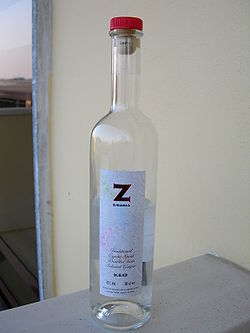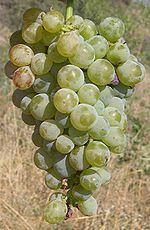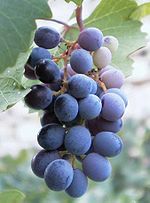
Zivania
Encyclopedia

Pomace
Pomace , or marc , is the solid remains of grapes, olives, or other fruit after pressing for juice or oil. It contains the skins, pulp, seeds, and stems of the fruit....
of grapes that were pressed during the wine-making process mixed with local dry wines produced from local grape varieties of Cyprus such as Xynisteri
Xynisteri
Xynisteri is an indigenous white grape grown on Cyprus. 13% of Cyprus vineyards, or 500 hectares on the south slopes of the Troodos mountain range are planted with this grape variety. It is used in the production of several local wines...
and Mavro
Mavro
Mavro is an indigenous red grape cultivated on the island of Cyprus. The grape takes its name from its dark colour. The Italian ampelographer, Count Giuseppe di Rovasenda refers to it in 1877 as Cipro Nero ....
. The distillation of zivania takes place in special apparatus similar to those used for the production of tsikoudia
Tsikoudia
Tsikoudia is an alcoholic beverage, a fragrant, grape-based pomace brandy of Cretan origin that contains 35%–60% alcohol by volume. Tsikoudia is made by distilling of pomace, i.e., the pieces of grapes that were pressed for the winemaking process...
in Crete
Crete
Crete is the largest and most populous of the Greek islands, the fifth largest island in the Mediterranean Sea, and one of the thirteen administrative regions of Greece. It forms a significant part of the economy and cultural heritage of Greece while retaining its own local cultural traits...
. Zivania is characterized by its taste and aroma. It is colorless and alcoholic with a light aroma of raisins. Its typical alcohol
Alcohol
In chemistry, an alcohol is an organic compound in which the hydroxy functional group is bound to a carbon atom. In particular, this carbon center should be saturated, having single bonds to three other atoms....
content is 45% by volume, but sometimes you can find Zivania's with up to 80-90% alcohol (Zivania-Lite). Zivania contains no sugars and has no acidity.
History
Zivania has been produced in Cyprus since the time the Republic of VeniceRepublic of Venice
The Republic of Venice or Venetian Republic was a state originating from the city of Venice in Northeastern Italy. It existed for over a millennium, from the late 7th century until 1797. It was formally known as the Most Serene Republic of Venice and is often referred to as La Serenissima, in...
ruled the island, around the end of the 15th century. Evidence of its continued production during Ottoman and British rule of the island comes from writers such as the British writer Samuel Baker
Samuel Baker
Sir Samuel White Baker, KCB, FRS, FRGS was a British explorer, officer, naturalist, big game hunter, engineer, writer and abolitionist. He also held the titles of Pasha and Major-General in the Ottoman Empire and Egypt. He served as the Governor-General of the Equatorial Nile Basin between Apr....
who in 1879 reports: "...the refuse of skins and stalks is laid upon one side to ferment for the manufacture of raki, or spirit, by distillation...". Since 1989, zivania has been protected under EU regulations a name for grape marc produced in Cyprus.
Production
 |
 |
In order to produce zivania of the highest grade, mature healthy grapes of the best quality are used. The grape must
Must
Must is freshly pressed fruit juice that contains the skins, seeds, and stems of the fruit. The solid portion of the must is called pomace; it typically makes up 7%–23% of the total weight of the must. Making must is the first step in winemaking...
used for the fermentation
Fermentation (food)
Fermentation in food processing typically is the conversion of carbohydrates to alcohols and carbon dioxide or organic acids using yeasts, bacteria, or a combination thereof, under anaerobic conditions. Fermentation in simple terms is the chemical conversion of sugars into ethanol...
should be of less than 13° Baumé
Baumé scale
The Baumé scale is a pair of hydrometer scales developed by French pharmacist Antoine Baumé in 1768 to measure density of various liquids. The unit of the Baumé scale has been notated variously as degrees Baumé, B°, Bé° and simply Baumé . One scale measures the density of liquids heavier than water...
, in order to get complete fermentation. As soon as the fermentation process completes (i.e. producing less or equal to 0° Baumé reading) the wine and pomace mixture is transferred to the main container of the distillation apparatus, called kazani and the distillation process begins. The first zivania that comes from the distiller has the highest alcohol content, while the last taken out of the apparatus has a low alcohol content and it is called porakos. Depending on the pre-distillation mixture, different qualities of zivania are produced:
- Only wine is used for the distillation
- Wine and pomace are used for the distillation
- Pomace with water and weak zivania are used
Storage and Transportation
Zivania is usually stored in clean wooden or galvanised metal containers that can be sealed in order to contain evaporationEvaporation
Evaporation is a type of vaporization of a liquid that occurs only on the surface of a liquid. The other type of vaporization is boiling, which, instead, occurs on the entire mass of the liquid....
. During transportation good care is taken not to damage the containers or allowing leakage or evaporation of zivania.
Usage
In Cyprus, other than enjoying zivania as an alcoholic drink, it is used for several other purposes. Zivania is used to treat wounds, for massaging sore body parts, as a remedy for colds and toothaches or as a warming-up drink during the cold months of winter, especially in the villages of the Troodos mountainsTroodos Mountains
Troodos is the biggest mountain range of Cyprus, located in the center of the island. Troodos' highest peak is Mount Olympus at 1,952 metres.The Troodos mountain range stretches across most of the western side of Cyprus...
.
In old times, the main alcoholic drinks Cypriots consumed were wine and zivania. In some villages of Cyprus, cinnamon
Cinnamon
Cinnamon is a spice obtained from the inner bark of several trees from the genus Cinnamomum that is used in both sweet and savoury foods...
was added to zivania giving it a nice red color and a fine aroma and flavor. As zivania ages it gains a stronger flavor and aroma. Aged zivania has been valued very highly and is kept for consumption during special occasions or as a welcoming treat for visitors. Even nowadays at some villages in Cyprus, local will welcome visitors with zivania served together with dried nuts, Turkish delight
Turkish Delight
Turkish delight or lokum is a family of confections based on a gel of starch and sugar. Premium varieties consist largely of chopped dates, pistachios and hazelnuts or walnuts bound by the gel; the cheapest are mostly gel, generally flavored with rosewater, mastic, or lemon...
, soutzoukos or small appetizers like Cypriot loukaniko
Loukaniko
Loukániko is the common Greek word for pork sausage, but in English it refers to the specifically Greek sausages flavored with orange peel, fennel seed, and various other dried herbs and seeds, and sometimes smoked over aromatic woods...
, lountza
Lountza
Lountza is a meat delicacy of Cyprus of dried, smoked pork tenderloin. The name may come from the Italian lonza stagionata.-Production:To produce lountza, pork tenderloin is first soaked in brine and then marinated in red wine. The marinated tenderloin is then dried and smoked. After smoking,...
and tsamarella
Tsamarella
Tsamarella is a Cypriot traditional food. It consists of meat, usually Goat, that is salted and cured for preservation. The process of preparation traditionally involves drying in the sun.-References:*...
.
Authenticity
To establish the authenticity of zivania chemical studies were contacted to investigate which of the metals analyzed constitute diagnostic parameters that establish authenticity. The results of the studies establish that zivania is related to the unique geological and climatic conditions existing on the island of Cyprus.Consumption
Zivania is served ice-cold with the local mezeMeze
Meze or mezze is a selection of small dishes served in the Mediterranean and Middle East as dinner or lunch, with or without drinks. In Levantine cuisines and in the Caucasus region, meze is served at the beginning of all large-scale meals....
, soutzoukos or dried fruit and nuts.
See also
- Pomace brandyPomace brandyPomace brandy is a liquor distilled from pomace. Examples include the Croatian / Montenegrin / Serbian lozovača , Cypriot zivania, French marc, Georgian chacha, German Tresterbrand, Greek tsipouro, Hungarian törköly, Italian grappa, Bulgarian grozdova, Portuguese aguardente, Romanian rachiu de...
- TsipouroTsipouroTsipouro is a pomace brandy from Greece and in particular Thessaly , Epirus, Macedonia, Mani Peninsula, and the island of Crete . Tsipouro is a strong distilled spirit containing approximately 45 percent alcohol by volume and is produced from the pomace...
- TsikoudiaTsikoudiaTsikoudia is an alcoholic beverage, a fragrant, grape-based pomace brandy of Cretan origin that contains 35%–60% alcohol by volume. Tsikoudia is made by distilling of pomace, i.e., the pieces of grapes that were pressed for the winemaking process...
- RakiaRakiaRakia is an alcoholic beverage that is produced by distillation of fermented fruit; it is a popular beverage throughout the Balkans. Its alcohol content is normally 40% ABV, but home-produced rakia can be stronger . Prepečenica is double-distilled rakia which has an alcohol content that may...
- PiscoPiscoPisco is a colorless or yellowish-to-amber colored grape brandy produced in winemaking regions of Chile and Peru. Pisco was developed by Spanish settlers in the 16th century as an alternative to orujo, a pomace brandy that was being imported from Spain...
- GrappaGrappaGrappa is an alcoholic beverage, a fragrant, grape-based pomace brandy of Italian origin that contains 35%–60% alcohol by volume...
- AguardienteAguardienteAguardiente , aiguardent , aguardente , and augardente are generic terms for alcoholic beverages that contain between 29% and 60% alcohol by volume...
- TörkölypálinkaTörkölypálinkaTörkölypálinka is a Hungarian pomace brandy, an alcoholic beverage produced by distillation from grape residues left over from winemaking. One of the oldest types of pálinka, it helps digestion, and is usually consumed in small quantities after meals.Under the 2008. LXXIII...
- Chacha (brandy)
- OrujoOrujoOrujo is the name in north-west Spain for pomace brandy . It is a transparent spirit with an alcohol content over 50%...

